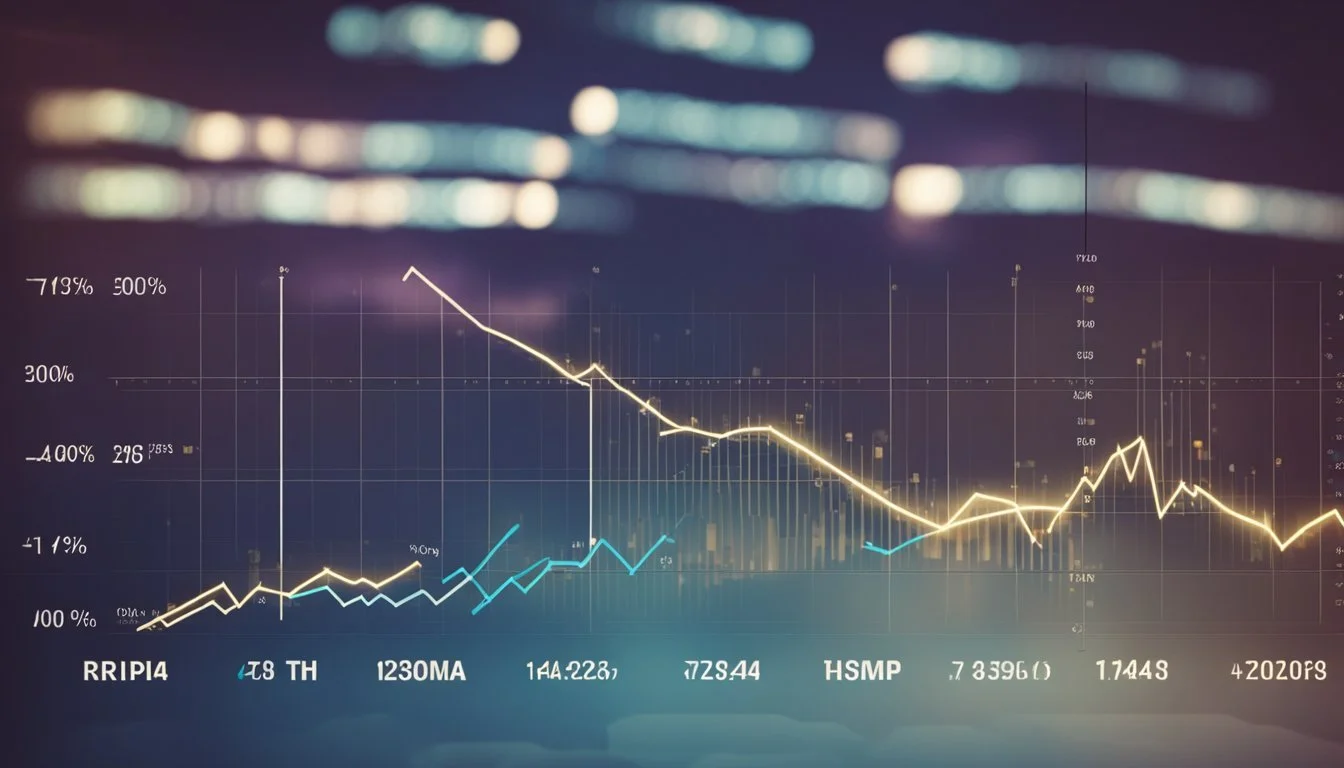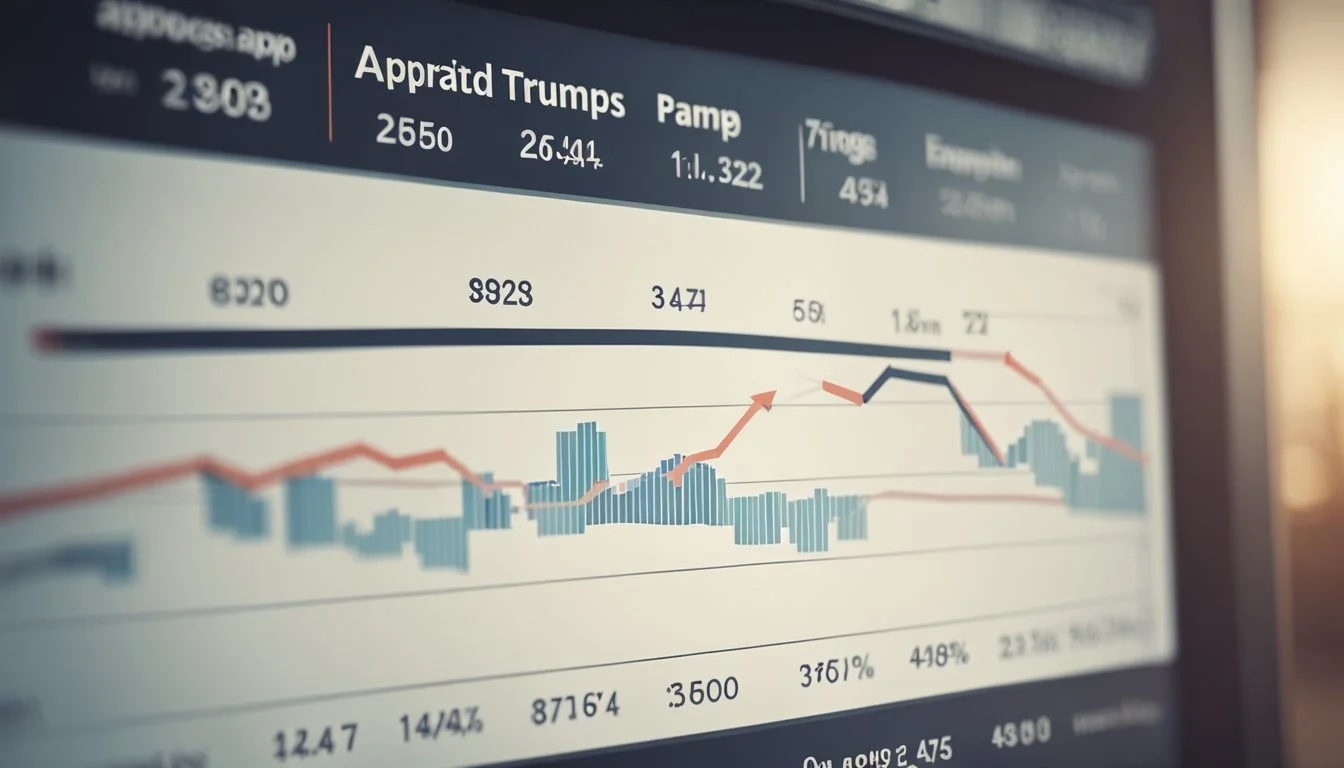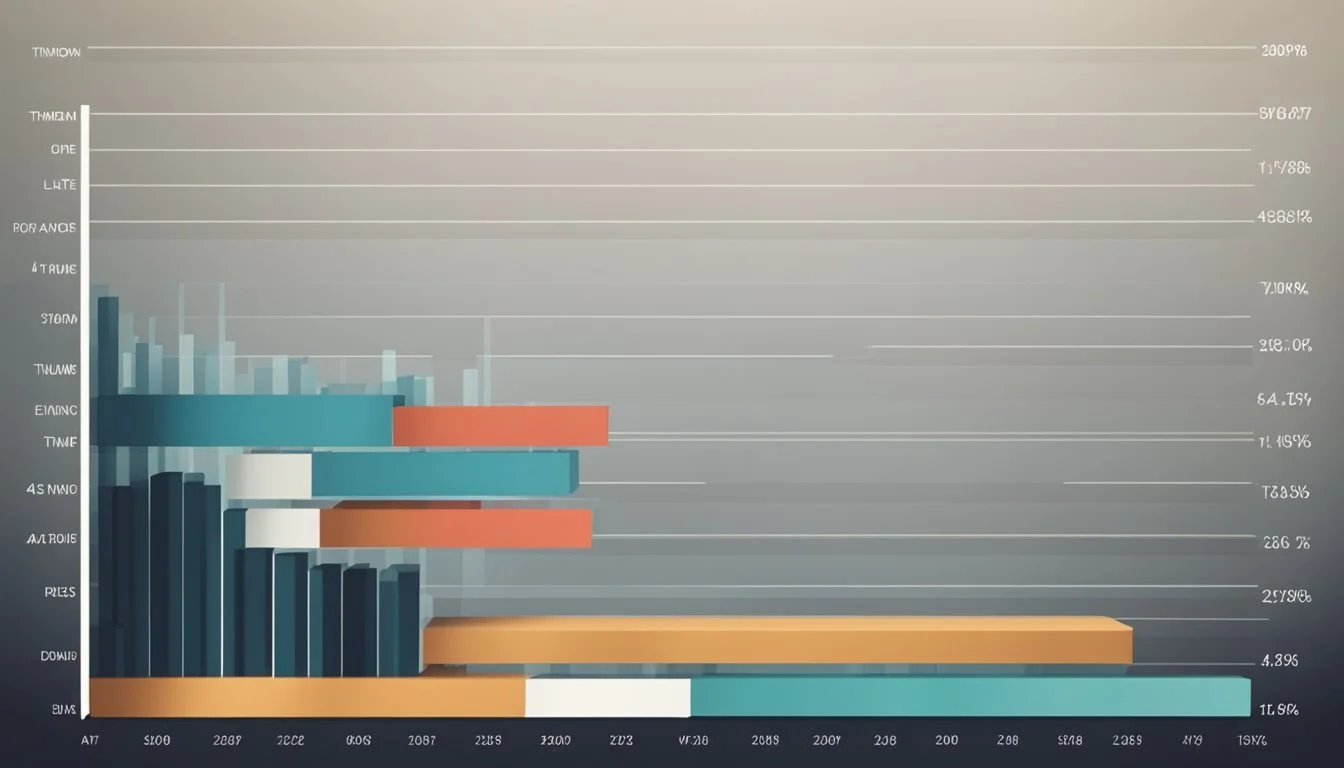Trump Popularity Plummets as Economic Worries Mount
Donald Trump's approval rating remains a topic of intense scrutiny as the 2024 presidential election approaches. The former president's popularity among voters continues to shape the political landscape and influence Republican Party dynamics.
Recent polls show Trump's favorability ratings hovering around 40%, with significant variations between different demographics and party affiliations. His core base of supporters remains loyal, while opposition remains strong among Democrats and many independents.
Trump's approval numbers have fluctuated since leaving office, affected by ongoing legal challenges and his continued presence in the media spotlight. These ratings play a crucial role in assessing his potential impact on the upcoming election cycle and his standing within the Republican Party.
Understanding Approval Ratings
Approval ratings provide a snapshot of public opinion towards political figures. They offer valuable insights into a leader's performance and popularity among constituents.
Definition and Significance
Approval ratings measure the percentage of people who approve of a political figure's job performance. These ratings are crucial for gauging public sentiment and can influence policy decisions, election strategies, and media coverage.
Pollsters regularly track approval ratings for presidents, governors, and other elected officials. High ratings often indicate strong public support, while low ratings may signal dissatisfaction or eroding confidence.
Fluctuations in approval can impact a leader's ability to advance their agenda. Politicians with higher ratings typically have more leverage in negotiations and may find it easier to rally support for their initiatives.
Methodology of Polling
Pollsters use scientific sampling techniques to gather approval rating data. They typically survey a representative cross-section of the population through phone calls, online questionnaires, or in-person interviews.
Sample sizes vary but usually range from 800 to 2,000 respondents for national polls. Larger samples generally yield more accurate results and lower margins of error.
Polls often include demographic information to ensure diverse representation. Pollsters may weight responses to align with population demographics.
Questions are carefully worded to avoid bias. A common format asks: "Do you approve or disapprove of the way [politician] is handling their job as [position]?"
Results are analyzed statistically, accounting for margins of error and confidence levels. Reputable pollsters disclose their methodology and potential limitations to maintain transparency.
Historical Approval Ratings
Donald Trump's approval ratings during his presidency provide insights when compared to past presidents. These figures offer a window into public sentiment and political dynamics over time.
Comparative Analysis
Trump's average approval rating throughout his presidency was 41%, according to Gallup polls. This places him below several recent predecessors. Barack Obama maintained an average approval of 47.9% during his tenure. George W. Bush averaged 49.4%, bolstered by high ratings following the September 11 attacks.
Trump's highest approval rating reached 49% multiple times in 2020. His lowest point came in January 2021 at 34%. These fluctuations reflect the polarized nature of his presidency. Trump's ratings showed less variability than some past presidents, with a range of 15 percentage points between his highest and lowest marks.
Presidential Averages
Historical context reveals Trump's ratings as relatively low. Harry Truman holds the record for highest average approval at 45.4%. John F. Kennedy follows at 70.1%, though his presidency was cut short. Recent presidents have faced more challenging approval environments.
Presidential approval ratings have become increasingly partisan over time. This trend affected Trump's numbers, with stark differences between Republican and Democratic voters. The gap between party lines widened during his term.
Trump's final approval rating of 34% ranks among the lowest for outgoing presidents. This figure reflects the tumultuous end to his presidency, including the January 6 Capitol riot.
Donald Trump's Approval Rating Over Time
Donald Trump's approval rating fluctuated significantly during his presidency. His ratings were influenced by major events and varied across different polling sources.
Initial Ratings Post-Inauguration
Donald Trump entered office with historically low approval ratings for a new president. Gallup polling showed his initial approval at 45% shortly after inauguration in January 2017. This was lower than any other president since Gallup began measuring presidential approval in the 1940s.
Trump's ratings remained in the low 40% range during his first year, rarely crossing 45%. His disapproval ratings consistently outpaced his approval numbers.
Impact of Major Events
Major events during Trump's presidency caused notable shifts in his approval rating. The passage of tax reform legislation in late 2017 led to a brief uptick, with some polls showing approval near 45%.
The government shutdown in early 2019 saw Trump's ratings dip into the high 30s. The COVID-19 pandemic initially boosted his numbers to the high 40s in March 2020, but this "rally 'round the flag" effect faded by summer.
Estimate Variations by Source
Different polling sources showed variations in Trump's approval estimates. FiveThirtyEight's polling average typically placed Trump's approval 2-3 points higher than RealClearPolitics.
Gallup's tracking poll often showed lower ratings for Trump compared to other sources. Their final measurement had Trump at 34% approval in January 2021.
Rasmussen Reports consistently gave Trump higher ratings, sometimes 5-10 points above other pollsters. Their final poll had Trump at 51% approval.
Factors Influencing Donald Trump's Rating
Donald Trump's approval rating fluctuated throughout his presidency due to various economic, domestic, and international factors. His policies and personal style played significant roles in shaping public opinion.
Economic Indicators
Trump's approval rating often correlated with economic performance. The stock market reached record highs during his term, boosting investor confidence. Unemployment rates fell to historic lows before the COVID-19 pandemic, particularly benefiting minority communities.
Tax cuts implemented in 2017 initially stimulated economic growth. Many businesses reported increased profits and expansion plans. However, the long-term effects on the national debt raised concerns among some voters and economists.
The trade war with China impacted certain sectors, especially agriculture. While some praised Trump's tough stance, others criticized the economic consequences.
Domestic Policies
Immigration policy significantly influenced Trump's rating. His promise to build a wall on the Mexican border energized his base but polarized public opinion. The implementation of travel bans from several Muslim-majority countries sparked legal challenges and protests.
Healthcare reform attempts, including efforts to repeal the Affordable Care Act, met resistance. This impacted his support among voters concerned about medical coverage.
Trump's response to racial justice protests in 2020 drew both praise and criticism. Law enforcement support boosted his rating among some demographics, while others viewed his approach as divisive.
Foreign Diplomacy
Trump's "America First" approach reshaped U.S. foreign policy. Meetings with North Korean leader Kim Jong-un initially raised hopes for denuclearization, though concrete results were limited.
The decision to withdraw from the Paris Climate Agreement and Iran nuclear deal pleased some supporters but worried others about global cooperation. Renegotiation of trade deals like NAFTA aimed to protect American interests but faced mixed reactions.
Relations with traditional allies experienced strain, particularly regarding NATO contributions. This impacted perceptions of U.S. leadership on the world stage.
Demographics and Approval Ratings
Donald Trump's approval ratings vary significantly across different demographic groups. These differences highlight the polarized nature of his support base and broader public opinion.
Party Lines Division
Republicans consistently show much higher approval for Trump compared to Democrats. In recent polls, over 80% of GOP voters express support for the former president. Democrats, in contrast, have approval ratings for Trump in the single digits or low teens. Independents tend to fall somewhere in between, though typically lean more negative than positive.
Trump's ratings among likely voters often exceed those of registered voters or adults overall. This reflects his ability to energize his base and drive turnout among supporters. The gap between his approval among Republicans versus the general public has remained quite wide throughout his political career.
Age and Regional Differences
Older voters tend to view Trump more favorably than younger generations. Surveys show his strongest support among those 65 and older, while millennials and Gen Z express much lower approval ratings. Regional divides are also apparent. Rural areas and the South give Trump his highest marks.
Urban centers and coastal states typically show much lower approval. Education level correlates strongly with Trump support as well. Voters without college degrees approve of Trump at higher rates than those with advanced education. White voters, particularly men, rate Trump more positively than other racial and ethnic groups.
Current Polling Data
Recent polls show a close race between Donald Trump and potential 2024 challengers. Approval ratings fluctuate but remain a key indicator of voter sentiment heading into the next election cycle.
Analysis of Latest Polls
A Wall Street Journal poll reveals Vice President Kamala Harris with a narrow 1-point lead over former President Trump. However, Trump maintains an advantage on key issues.
FiveThirtyEight's polling average indicates mixed results for Trump's favorability. Their data aggregates multiple surveys to provide a comprehensive view of public opinion.
Quinnipiac University and Morning Consult polls have shown varying levels of support for Trump among Republican voters. These fluctuations reflect the dynamic nature of the political landscape.
Projected Trends
Polling experts anticipate continued volatility in Trump's approval ratings as the 2024 election approaches. Factors like economic conditions, ongoing legal challenges, and campaign messaging are likely to influence public perception.
Analysts from firms like YouGov and Ipsos predict that Trump's core base of supporters will remain relatively stable. However, his appeal to independent voters may shift based on current events and policy debates.
Reuters/Ipsos tracking polls suggest Trump's approval among Republicans could face challenges from other potential GOP candidates. This may impact his overall standing in national surveys.
Public Opinion and Media Perception
Donald Trump's approval ratings have been a subject of intense scrutiny and debate. Media coverage and public sentiment have played significant roles in shaping perceptions of the former president.
Media's Role in Shaping Opinion
News outlets have heavily influenced public views on Trump. Conservative media often portray him favorably, highlighting his policy achievements and strong base support. Liberal-leaning sources tend to focus on controversies and criticisms.
Television coverage has been particularly impactful. Cable news channels dedicate extensive airtime to Trump-related stories, both positive and negative. Social media platforms amplify these narratives, creating echo chambers that reinforce existing opinions.
Fact-checking efforts by journalists have become more prominent during and after Trump's presidency. These attempts to verify claims have affected public trust in both the media and political figures.
Approval vs. Disapproval Narratives
Trump's approval ratings have fluctuated throughout his political career. His core supporters remain steadfast, while opposition has been consistent.
Recent polls show:
35% view Trump favorably
63% hold an unfavorable opinion
Republican voters maintain stronger support:
66% of Republicans view Trump favorably
32% have an unfavorable opinion
Trump's job approval rating reached a low point of 29% at the end of his presidency. This sharp decline reflected a real shift in public opinion following specific events.
Disapproval narratives often focus on controversies, policy decisions, and personal conduct. Approval narratives emphasize economic performance, judicial appointments, and appeals to traditional conservative values.
Comparisons to Other Presidents
Donald Trump's approval ratings throughout his presidency provide an interesting point of comparison to his predecessors. His numbers deviated from historical trends in several notable ways.
Trump vs. Predecessors
President Trump's average approval rating during his term was 41%, according to Gallup polling. This placed him lower than most modern presidents. Barack Obama averaged 48% approval, while George W. Bush averaged 49%.
Trump never reached 50% approval in Gallup's polling. This is unique among post-World War II presidents. Even presidents who lost re-election bids, like Jimmy Carter and George H.W. Bush, exceeded 50% at some point.
Trump's highest rating was 49%, reached several times in 2020. His lowest was 34% in 2021 after the January 6 Capitol attack.
Approval Rating Contextualized
Trump's approval remained remarkably stable compared to other presidents. His ratings typically ranged between 35-45%. This stability was unusual historically.
Most presidents see larger swings as events impact public perception. Harry Truman, for example, saw his approval plummet from 87% to 22% during his presidency.
Trump's base remained loyal throughout his term. His approval among Republicans consistently exceeded 80%. This strong party support helped keep his overall numbers from falling further despite controversies.
Polarization likely contributed to Trump's stable but lower ratings. Democrats gave him historically low approval, while Republicans remained supportive regardless of events.
Looking Ahead
Donald Trump's approval ratings will play a crucial role in shaping the political landscape. His influence extends beyond his own potential candidacy, affecting party dynamics and voter sentiment.
Impact on Future Elections
The 2024 U.S. Presidential Election looms large on the horizon. Trump's approval ratings may influence the Republican Party's strategy for candidate selection. A strong showing could bolster his chances if he decides to run again.
Midterm elections will also feel the impact of Trump's popularity. GOP candidates may align themselves with or distance themselves from the former president based on his approval numbers.
Democrats will likely factor Trump's ratings into their campaign strategies. They may focus on contrasting their policies with his record or emphasizing the need for change.
Speculations on Political Strategy
The Republican Party faces a critical decision regarding Trump's role. High approval ratings among GOP voters could lead to continued embrace of his policies and rhetoric.
Some Republicans may seek to carve out their own political identities while still appealing to Trump's base. This delicate balancing act could shape the party's future direction.
Trump's team may adjust their messaging based on approval trends. They could focus on issues where he polls well or address areas of weakness to broaden his appeal.
Potential challengers within the GOP will closely monitor Trump's ratings. Weak numbers might embolden rivals to launch primary campaigns against him.





